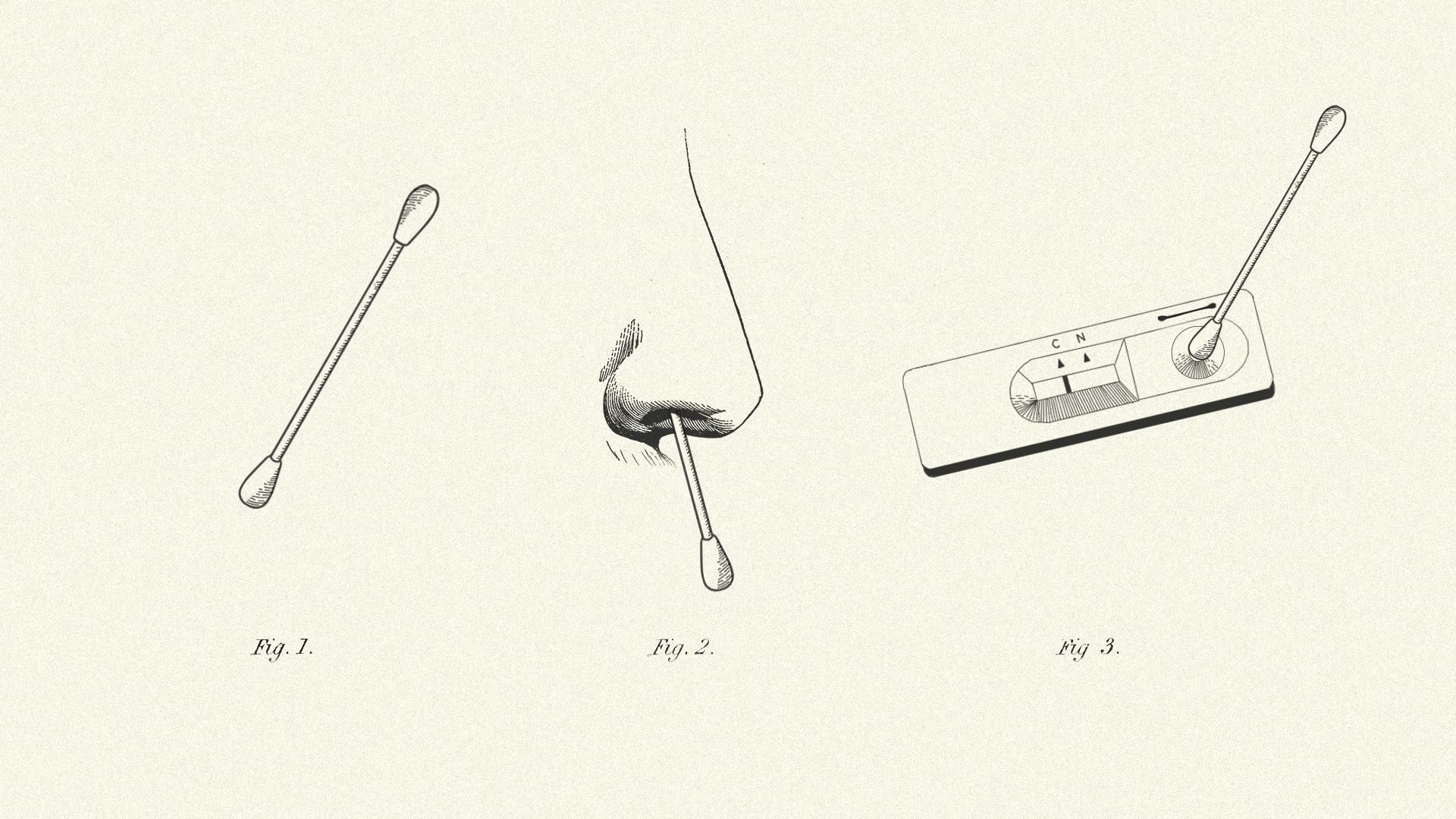| | | | | | | Presented By General Motors | | | | Axios Future | | By Bryan Walsh ·Apr 28, 2021 | | Welcome to Axios Future, which is T-minus three days to full vaccination status. - If you haven't subscribed, do it here.
- Send feedback, tips and ideas about what to do while you wait 15 minutes to view the result of your rapid COVID test (see item No. 1) to bryan.walsh@axios.com.
Today's Smart Brevity count: 1,770 words or about 6 1/2 minutes | | | | | | 1 big thing: How to use rapid at-home COVID tests the right way |  | | | Illustration: Aïda Amer/Axios | | | | Multiple brands of rapid COVID-19 tests that can be taken at home without a doctor's prescription are finally available over the counter. Why it matters: Rapid at-home COVID-19 tests put the power of diagnostics in the hands of individual consumers, allowing anyone to surveil themselves regularly for the coronavirus. But getting the most out of them requires a new paradigm around diagnostics — and ultimately, driving down the cost. What's happening: Abbott's BinaxNow rapid test is available in retail pharmacy chains like Walgreens and CVS, as well as online, at a suggested price of $23.99 for a two-test kit. - Quidel's QuickVue rapid test also comes in a pack of two tests and is available online now for about $30.
- Australia-based Ellume's rapid test will be available in stores and online by the end of May for $38.99.
Context: All of the rapid tests — which can deliver results in as little as 10 to 15 minutes — were developed months ago, but were only recently given emergency use authorization by the FDA. How it works: Rapid tests work differently than PCR tests, which require visiting a clinic or testing site and giving a nasal swab that is then analyzed by a lab for the genetic material of the SARS-CoV-2 virus. - Rapid tests instead look for the presence of a viral antigen — a protein on the surface of the virus that elicits an immune response — that indicates an active infection.
What they're saying: "We see a transition to asymptomatic testing with these diagnostics to get people back to work and school," says Douglas Bryant, CEO of Quidel. "Studies demonstrate that if we can do these tests a couple of times a week, we won't have to go back into lockdown." That means using the test more for what Bryant calls "serial testing" for regular self-surveillance and less as a one-off to identify a likely infection. - In the case of Abbott's BinaxNow, users remove a test card and place six drops of included chemical reagent in a slot on the card.
- Users then self-collect a nasal sample with an included swab and insert the swab into another slot in the test card, where it is rotated three times to ensure it mixes with the chemical reagent.
- The card is then sealed, and after 15 minutes, results will be ready, with two pink or purple lines indicating a positive result — meaning an active infection — and one line indicating a negative result.
The catch: A big obstacle for rapid antigen testing is cost: At a minimum of $25 per kit, the current generation of rapid tests is still too expensive for most people to test themselves on a regular basis, which is what needs to happen to get the most out of the new diagnostics. - Mass rapid at-home testing would likely require a dedicated government program. In England, everyone in the country is being given access to two tests a week as part of the government's $51 billion Test and Trace program.
What to watch: The CDC and NIH recently launched the first public health initiative in the U.S. to test the effectiveness of rapid at-home tests in curbing COVID-19 outbreaks. The bottom line: Rapid at-home tests put the power of diagnosis and surveillance in the hands of ordinary Americans, but as with the vaccines, it will only work if we use them. |     | | | | | | 2. U.S. population growth is on a downward slope |  | | | An empty playground in New York City. Photo: Noam Galai/Getty Images | | | | New data from the U.S. census shows that American population growth in the 2010s was the slowest since the 1930s, and COVID-19 will likely be a further drag. Why it matters: Demography has always been destiny, and America's sheer size and relatively young age have been vital components to its global influence. An America that grows slower and older will face new challenges around economics and innovation. By the numbers: The first data from the 2020 U.S. census, released this week, indicates that as of April 1, 2020, the U.S. population stood at 331.5 million people. - That represents a 7.4% increase between 2010 and 2020, which is the second-slowest rate of expansion, after the 1930s, since the government began taking a decennial count in 1790.
- The new estimates also show that the U.S. population grew by just 0.35% between July 1, 2019 and July 1, 2020 — the lowest annual growth rate since at least 1900.
- An analysis from the AP indicates that births for all of 2020 were down 4.3% from 2019, and that births from last December through January and February 2021 — nine months after the spring lockdowns that some thought might lead to a COVID baby boom — were down 6.5%, 9.3% and 10% respectively from the previous year.
The big picture: Slowing population growth is a result of a declining birthrate, declining life expectancy and declining immigration. - Put that together and you have a population that is still growing, but much more slowly than in the past, and a country that is increasingly old.
- Census data indicates there are now more Americans 80 years or older than those 2 years or under.
Context: Slower population growth may seem like a boon in a time of increasing anxiety over climate change — not to mention a housing shortage — but aging and eventually shrinking demographics could lead to a bleaker and weaker country. Yes, but: It could be worse — the Financial Times reported that China is expected to announce its first overall population decline since the killer famines of the 1950s, leaving the country with a shrinking population of young workers to support an enormous number of elderly. The bottom line: The U.S. has one major advantage over China in the demographic wars — millions of people actually want to move here. - But whether or not they're permitted to will depend on immigration policy.
|     | | | | | | 3. Air Force research taps quantum computing |  | | | Illustration: Sarah Grillo/Axios | | | | U.S. Air Force researchers are partnering with a quantum computing company to use its machine learning algorithms. Why it matters: Quantum is the next generation of computing, and its growing adoption by the military shows the progress of the technology as it gradually moves out of the lab and into the real world. Driving the news: On Tuesday the Air Force Research Laboratory (AFRL) — its technological development wing — will announce a partnership with the quantum computing software company QC Ware to harness its algorithms to better surveil unmanned aircraft. - QC Ware will design and deliver quantum algorithms that are capable of clustering and classifying the flight plans of objects many times faster than the classical machine learning algorithms that are currently used for the job.
- Using currently available quantum computing hardware, the algorithms will be tested with real-life data, with the aim of determining how many qubits — the basic unit of quantum computing power — are needed for the system to run accurately, as well as the maximum allowable error rate of the calculations.
What they're saying: "The question is, if you have a number of data points, like satellite images or flight paths, can you group them together so that you can assign some sort of meaning to all the signals you have out there?" says Iordanis Kerenidis, head of quantum algorithms at QC Ware. The bottom line: Even some experts believe there has been more hype than reality to quantum computing so far, which makes real-world experiments like this one all the more necessary. Read the whole story. |     | | | | | | A message from General Motors | | General Motors sets new goal to be carbon neutral by 2024 | | |  | | | | Driven by our transition to EVs, we have set a goal for carbon neutrality in the next 20 years—not just in our operations, but in our products, too. It's our pledge to help get us closer to our vision of an all-electric future. Learn more about General Motors' efforts. | | | | | | 4. Jill Tarter's search for life |  | | | Photo illustration: Annelise Capossela/Axios. Photo: Roger Ressmeyer/CORBIS/VCG via Getty Images | | | | Astronomer Jill Tarter wants the search for extraterrestrial intelligence (SETI) to be taken seriously, my Axios colleague Miriam Kramer writes. Why it matters: SETI as a scientific field has long played second fiddle to other, well-funded searches for direct and indirect signs of life — like NASA's Mars program and the hunt for alien planets around distant stars. What's happening: Instead of generally referring to SETI as a search for smart aliens, Tarter is focusing on the search for "technosignatures" — signs of technology like geoengineering or large structures in orbit from distant civilizations. - "We can't define intelligence, and we certainly don't know how to find it at a distance, directly," Tarter told Miriam. "What we can do is to look for evidence of somebody else's technology that might be discernible over interstellar distances."
- If scientists on Earth happen to discover those massive signs of intelligent civilizations, however, they were likely created by a more advanced society because anything scientists could pick up from this far away would need to be particularly large for researchers to see it.
Between the lines: By putting technosignatures in the same conversation as biosignatures — biological signs of life on other planets like Mars — Tarter hopes both searches will be able to play off of one another. - "The exoplanets and extremophiles are pointing out that there is a lot more potentially habitable real estate out there than we ever imagined," Tarter said.
- She also added that "the next obvious question is, are they inhabited by intelligent beings?"
Read the whole story. |     | | | | | | 5. Worthy of your time | | Hackers used to be humans. Soon, AIs will hack humanity (Bruce Schneier — Wired) - Long-lost Nigerian princes are on the way out. The next generation of AI-driven hacking will be far more precise.
The slander industry (Aaron Krolik and Kashmir Hill — New York Times) - The internet has become a weapon of mass reputation destruction, and the players meant to protect us are often the same ones facilitating the lies.
There's no place like home — and the labor market needs to adjust (Rana Foroohar — Financial Times) - Remote working technology offers a place-based approach to work that could help revitalize fading hometowns.
The challenges of animal translation (Philip Ball — The New Yorker) - How AI could help us learn how to talk like the animals do.
|     | | | | | | 6. 1 deep time thing: 40 days in a cave |  | | | Participants in the Deep Time project leave the Lombrives cave on April 24. Photo: Fred Scheiber/AFP via Getty Images | | | | Fifteen people this week emerged from living in total isolation in a cave in France for 40 days as part of an experiment in "Deep Time." Why it matters: Without smartphones and clocks the participants were forced to simply be with themselves. In doing so, they provided an object lesson for how artificially regulated our modern lives have become. How it works: The Deep Time research project, led by France's Human Adaptation Institute, took seven women and eight men — all volunteers — and sent them to live in the Lombrives cave for nearly six weeks. - Aside from cameras and tools to measure their sleep and movement patterns, the participants had no access to technology, spending all of their time in an environment with no natural light and temperatures of around 50 F and 100% humidity.
- When they finally emerged from the cave — wearing special sunglasses to protect their unaccustomed eyes from the sun — they had no idea how much time had passed, with one participant estimating as few as 23 days.
Details: That's because without clocks or sunlight, they measured the passing of time mostly in sleep cycles, which varied from person to person. What they're saying: "Time went by so fast and I still had, like, so [many] things I wanted to do in the cave," Marina Lançon, a Montreal expedition guide, told the CBC. The bottom line: Two-thirds of the participants said they wanted to stay underground and in isolation a little longer — which, given the current state of the world, perhaps isn't that surprising. |     | | | | | | A message from General Motors | | General Motors sets new goal to be carbon neutral by 2024 | | |  | | | | Driven by our transition to EVs, we have set a goal for carbon neutrality in the next 20 years—not just in our operations, but in our products, too. It's our pledge to help get us closer to our vision of an all-electric future. Learn more about General Motors' efforts. | | | | | | Axios thanks our partners for supporting our newsletters.
Sponsorship has no influence on editorial content. Axios, 3100 Clarendon Blvd, Suite 1300, Arlington VA 22201 | | | You received this email because you signed up for newsletters from Axios.
Change your preferences or unsubscribe here. | | | Was this email forwarded to you?
Sign up now to get Axios in your inbox. | | | | Follow Axios on social media:    | | | | | |








No comments:
Post a Comment